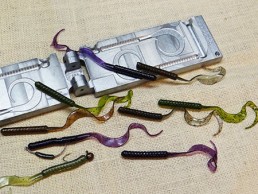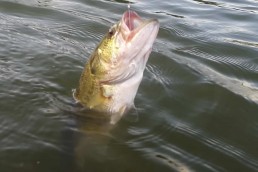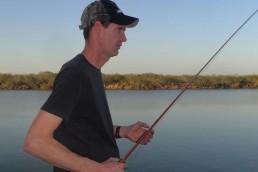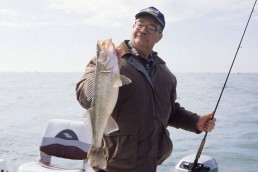The Ribbon Worm: Bass Fishing’s Old Faithful
SHARE THIS POST
When I looked back on my 2015 season, I realized that I had caught and released three of the biggest largemouth bass of my life. And in all three cases, there was a common denominator.
The first two came in June on a family vacation near the hometown of “the Mouse,” in Kissimmee, Fla.—no, not a fancy guided trip to Lake Toho or anything. They were in two retention ponds that I found on a previous trip many years ago. Like a lot of you, if I see a piece of water, I will see if there are fish in it.
One pond had some weeds, but wacky worming was just futile, as I was getting hung up constantly. I scanned through my limited tackle I had along and decided to go with a worm rigged Texas-style with small bullet weight and an offset worm hook. The worm was Do-It’s Essential Series 7-inch Ribbon Worm. The bass were spooky in the clear water, but on my second morning, and after a few 16- to 18-inchers, the weedy pond gave up a 22-inch brute—one that alone would’ve made my week.
Pond two was virtually weed-free, but also gin-clear. Though weedless, the bottom had a weird slime on it that would build up on a bullet nose sinker. Back to my bag of tricks, I found a belly-weighted hook with a screw lock for the nose of the bait. The bait was a 7-inch ribbon worm. The combination could be reeled ever so slowly along the bottom. And because it never went nose down, it completely avoided all that bottom slime. That pond didn’t have as much action, but every fish was big, including a 22.5-inch bass that beat the 22-incher caught earlier in the week.
Now, let’s fast forward in the review of the past season to August and another small pond. This one is 1,200 miles north of Kissimmee, and was a remote lake in Oneida County in Wisconsin. It’s a lake we have driven past for years, and had wondered if there was any fish in it or if it was accessible. It was one of those situations where you could only dream that no one fished it for years and the fish hadn’t ever seen a lure.
At the last moment before this trip, I grabbed my old float tube and fins and packed them in the boat “just in case.” One afternoon I felt a little adventurous, and the opportunity came. I had hiked down the road earlier in the week to see where I could get in. My best shot was a steep gravel path that was made by years of “gully washer” storms. I got myself into the lake and started exploring. Gin-clear water, no weeds or no structure—very strange. My shore-casting attempts came up with nothing but stick worms getting pecked by small bluegills. But before I gave up I tried one last thing: move out near the middle of the lake and try deeper water. I tied on a 3/16-ounce Do-It Worm Nose Jig and rigged it with a 7-inch Ribbon Worm.
Literally on my first cast in deep water I had a thump and set the hook, but the fish got off quickly. I think he caught me by surprise. I continued working deep, and a few minutes later after swimming the worm slowly along the bottom, I got another thump. I was ready for this one and locked up with a nice 18-inch largemouth.
Are you enjoying this post?
You can be among the first to get the latest info on where to go, what to use and how to use it!
My next one was a “light” thump and I stuck it instantly with the sticky, sharp exposed hook of the Worm Nose head. This one stayed down and bulldogged the bottom; it didn’t even fight like a bass. After a few minutes and getting spun around the float tube a few times, the beast came to the surface where I grabbed it. The mouth was huge and so was the belly. Being at water level with it was spectacular. The tale of the tape was 21.5 inches.
As I mentioned, looking back at the hundreds of bass I caught and released this year, my three most spectacular were all caught on 7-inch ribbon worms. Not just any, but ones I hand-poured with Do-Its Essential Series 7-inch Ribbon Worm mold.
I’ve used ribbon worms all my life; they have always been one of my go-to worms. This one is special, even at slow speeds the tail swims very seductively, making it a great worm from spring through fall. The segmented body allows you to cut it shorter if needed without it looking like you “cut” it. The Essential Series Ribbon Worm mold is under $40, so at $5 per bag for brand name worms this mold pays for itself in less than a year for most anglers and quicker for all you bass enthusiasts. And, you can create your own colors and not have to compromise and take what the store has in stock. I love purple for bass, but most manufactures put too much purple glitter in them. I either cut down on the purple glitter or use black glitter and the results are remarkable. My smoke with red glitter is much lighter and more transparent than commercial “smoke” lures. This can make a huge difference in clear-water situations. One of my hottest colors is a watermelon with black flake. Pretty common, but I add a hint of very fine gold glitter and a tiny dash of pearl. Those two subtle hints of color completely make that lure come alive. In fact, that tiny pinch of pearl in any color really gives it a pop that you never see in a store-bought worm.
The Essential Series mold is the most economical way to make the ribbon worms. It has two cavities so you can make two at a time. Do-It also makes seven other ribbon worm molds in their traditional machined aluminum series that vary from 4.75 inches up to a monster 14-inch worm for the real giants.
And don’t think this is only for largemouths. The slender body of this worm also lends itself to the smallmouth bass.
What hit me this season was its versatility—Texas rigging it behind a bullet sinker in the weeds, rigging it weedless on a screw-lock post and a 3/0 Mustad 91768 hook and 1/8-ounce weight (Do-It Mold SMB-4-MTD) or rigging it on the Do-It Worm Nose Jig (model WORM-A) in weights from 1/8 to 1/4 ounce. They also work well on Stand–Up heads, as additions on rubber-legged bass jigs and even as a trailer on spinnerbaits.
The Ribbon Worm proved itself again and again this year for me. From central Florida to northern Wisconsin, it caught big bass for me all year long. If you are a bass fisherman you will want this in your arsenal. But the real beauty is being able to make that exact color that you want. Some colors are just a tweak off of what is normally available, like the pearl accents I mentioned; some are just plain off-the-wall colors. Have you ever used fluorescent orange worms? In murky water they can be incredible. You don’t see those on the tackle store hooks. Get some Ribbon Worms ready for next season. You won’t be disappointed and it’s always much sweeter catching a fish on a lure you made yourself.
MWO
SHARE THIS POST
Did you enjoy this post?
You can be among the first to get the latest info on where to go, what to use and how to use it!
Marc Wisniewski
Marc Wisniewski is an avid Wisconsin angler specializing in Lake Michigan shore and inshore fishing. He also chases bass, pike, and muskies anywhere he can. He has built custom rods for 35 years and makes lures from wood, lead and soft plastics. Wisniewski has been writing fishing articles for more than 30 years.




